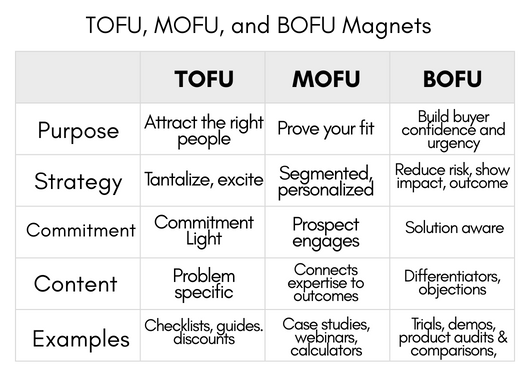If I were to ask you about your referral sources, could you tell me from where you receive your referrals? How about the number of leads from each source? What about the top referral sources? If you are not tracking and managing your referral sources, you could be heading towards Follow Up Fatigue. Follow Up Fatigue occurs when you are spending all of your time following up sales leads, qualified and unqualified, rather than building the referral sources that send leads to you.
What is a referral source?
A referral source is how a prospect finds out about your business, service, and/or product. The prospect is usually in the consideration stage of the Buyer’s Journey when they are researching a solution for their need. Common referral sources are organic search, advertising (i.e. Google Adwords, YouTube ads,), social media, and earned media (i.e. customer reviews, word-of-mouth recommendations,).
Let’s use an example to illustrate. Tom owns a paint store. He targets home builders, landlords, and individual homeowners. Tom has 4 referral sources:
- Ads: Tom runs a Google Adwords campaign so people can find his website when they search for house paint and other similar words.
- Google Display Ads: Tom displays ads on other websites through Google’s display network which targets homebuilders and contractors.
- Social media: Tom shares posts several times a week on Facebook and Instagram about promotions, color scheme ideas, and company culture.
- Customer reviews: Tom’s salespeople reach out to satisfied customers who fit the profile of someone most likely to advocate for his business with a positive review.
The first two referral sources take time and money (i.e. marketing budget) to manage, the third referral source takes time to create posts, and the fourth referral source takes time to follow up and nurture customers who are likely to refer his business.
Every business owner knows that it is necessary to have a marketing budget to build brand awareness and attract leads. Business owners also know that customer reviews and referrals are golden. Tom, the business owner, is doing both. However, he is not tracking his referral sources. He has a CRM and every prospect is added to the CRM, but if he is not tracking his referral sources, he is going to fall victim to Follow Up Fatigue. Here’s how:
- Tom does not know how each prospect found him. Is it social media? Is it an ad? Is it a customer referral?
- Tom does not know which referral source is performing best and which one is not, so he equally delegates time and money to all the sources. He may be wasting money on ads OR not spending enough. His social media posts may be building a relational bond with prospects because they want to buy from a local business OR people like his post, but it isn’t really converting anyone to become a customer.
- Tom does not know which prospect in his CRM is qualified and which one is not.
This causes Tom to follow up endlessly with everyone, and he comes home every night exhausted because he spends too much time trying to convince unqualified leads to buy and not enough time to nurture qualified leads.
There is a solution to this. Our paint store owner can use his CRM to manage to his referral sources more effectively. In order to this, he needs to follow these practices which will increase qualified leads and reduce Follow Up Fatigue.
Identify the referral sources
You may or may not intentionally be using different avenues to attract prospects. Either way it is a good idea to audit and identify them, because referral sources bring different prospects. Google might bring people who are researching solutions. Facebook might bring people who want to know what their friends think, and customer review sites might bring people who view customer experience as a big factor in their decision making.
Set up your CRM to track leads from referral sources
If you are not tracking how someone became a prospect, you are missing out on valuable data that shows you what is working and what is not. Here are 3 ways to track your referral sources:
- Use a phone call tracking app or add-on that integrates with your CRM so you know if someone found you through a phone listing through Google My Business or another business directory. Ghost numbers are a common practice to track which listing.
- Use landing pages on your website with unique lead generation forms from your CRM. These landing pages are beneficial when you are running different campaigns such as Facebook promotion, Google Adwords, and Yelp business profile pages. Unique lead generation forms help you see which referral source is attracting people.
- Set up a referral program to identify customers who are referrer champions. Tracking your referrers will help you identify other customers who can be potential champions.
Create referral source performance reports
Tracking referral sources is good, but you also need to run reports in your CRM to evaluate and review performances. This is important so that you are using your marketing budget and time in the most profitable way. After all, you want highly qualified prospects to contact you. Here are three reports to help you get started:
- # of Leads – How many leads does each referral source bring in a specific timeframe
- # of Conversions – How many prospects become customers from each referral source
- # of Follow-ups – What is the average number of follow-ups required to convert prospects to customers with each referral source
Conclusion
Referral sources are an amazing way to bring prospects to your business, and building them can reduce Follow Up Fatigue. We use our CRMs to lead prospects from referral sources through the buyer’s journey and turn them into customers. However, this is most effective when we are tracking the referral source performance. If you would like to learn more about referral sources and how you can use a CRM to track leads from referral sources, contact us at 301-332-0613 or fill out the form for a free demo. We will show you how you can get qualified leads from referral sources.






